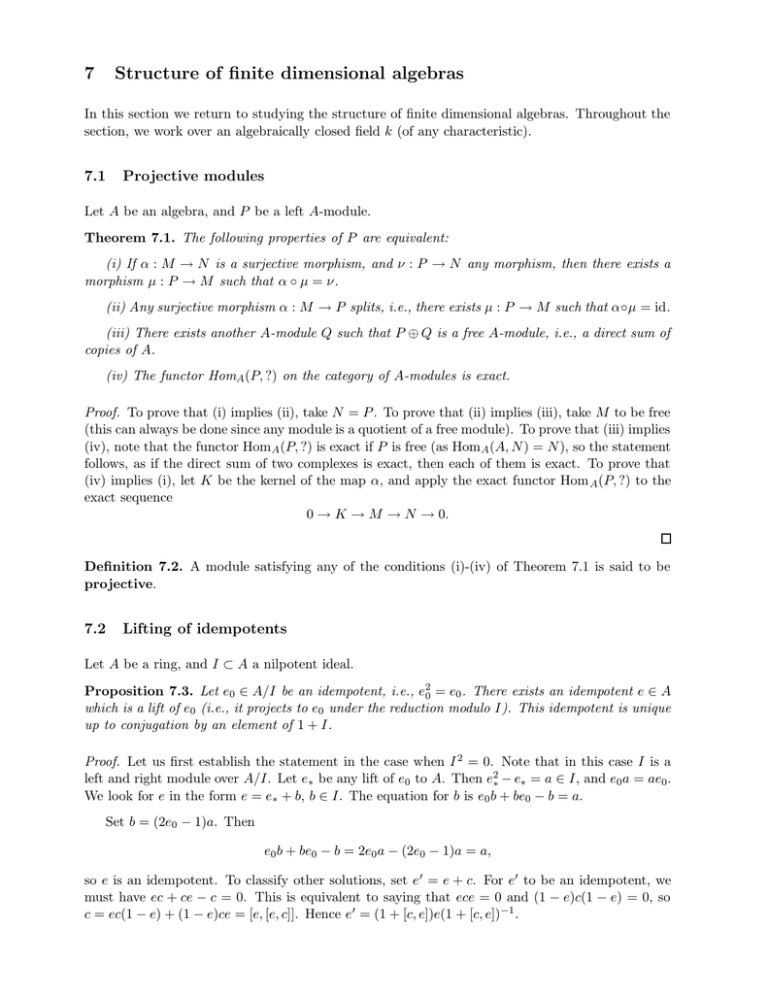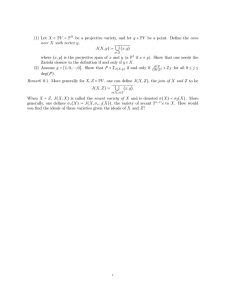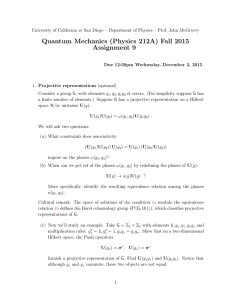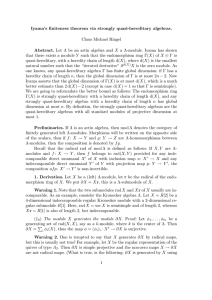7 Structure of finite dimensional ...
advertisement

7 Structure of finite dimensional algebras In this section we return to studying the structure of finite dimensional algebras. Throughout the section, we work over an algebraically closed field k (of any characteristic). 7.1 Projective modules Let A be an algebra, and P be a left A-module. Theorem 7.1. The following properties of P are equivalent: (i) If ϕ : M ⊃ N is a surjective morphism, and λ : P ⊃ N any morphism, then there exists a morphism µ : P ⊃ M such that ϕ ∞ µ = λ. (ii) Any surjective morphism ϕ : M ⊃ P splits, i.e., there exists µ : P ⊃ M such that ϕ∞µ = id. (iii) There exists another A-module Q such that P � Q is a free A-module, i.e., a direct sum of copies of A. (iv) The functor HomA (P, ?) on the category of A-modules is exact. Proof. To prove that (i) implies (ii), take N = P . To prove that (ii) implies (iii), take M to be free (this can always be done since any module is a quotient of a free module). To prove that (iii) implies (iv), note that the functor Hom A (P, ?) is exact if P is free (as Hom A (A, N ) = N ), so the statement follows, as if the direct sum of two complexes is exact, then each of them is exact. To prove that (iv) implies (i), let K be the kernel of the map ϕ, and apply the exact functor Hom A (P, ?) to the exact sequence 0 ⊃ K ⊃ M ⊃ N ⊃ 0. Definition 7.2. A module satisfying any of the conditions (i)-(iv) of Theorem 7.1 is said to be projective. 7.2 Lifting of idempotents Let A be a ring, and I → A a nilpotent ideal. Proposition 7.3. Let e0 � A/I be an idempotent, i.e., e20 = e0 . There exists an idempotent e � A which is a lift of e0 (i.e., it projects to e0 under the reduction modulo I). This idempotent is unique up to conjugation by an element of 1 + I. Proof. Let us first establish the statement in the case when I 2 = 0. Note that in this case I is a left and right module over A/I. Let e⊕ be any lift of e0 to A. Then e⊕2 − e⊕ = a � I, and e0 a = ae0 . We look for e in the form e = e⊕ + b, b � I. The equation for b is e0 b + be0 − b = a. Set b = (2e0 − 1)a. Then e0 b + be0 − b = 2e0 a − (2e0 − 1)a = a, so e is an idempotent. To classify other solutions, set e � = e + c. For e� to be an idempotent, we must have ec + ce − c = 0. This is equivalent to saying that ece = 0 and (1 − e)c(1 − e) = 0, so c = ec(1 − e) + (1 − e)ce = [e, [e, c]]. Hence e � = (1 + [c, e])e(1 + [c, e])−1 . Now, in the general case, we prove by induction in k that there exists a lift e k of e0 to A/I k+1 , and it is unique up to conjugation by an element of 1 + I k (this is sufficient as I is nilpotent). Assume it is true for k = m − 1, and let us prove it for k = m. So we have an idempotent em−1 � A/I m , and we have to lift it to A/I m+1 . But (I m )2 = 0 in A/I m+1 , so we are done. Definition 7.4. A complete system of orthogonal idemp ⎨ otents in a unital algebra B is a collection of elements e1 , ..., en � B such that ei ej = ζij ei , and ni=1 ei = 1. Corollary 7.5. Let e01 , ..., e0m be a complete system of orthogonal idempotents ⎨ in A/I. Then there ei = 1) in A which exists a complete system of orthogonal idempotents e 1 , ..., em (ei ej = ζij ei , lifts e01 , ..., e0m . Proof. The proof is by induction in m. For m = 2 this follows from Proposition 7.3. For m > 2, we lift e01 to e1 using Proposition 7.3, and then apply the induction assumption to the algebra (1 − e1 )A(1 − e1 ). 7.3 Projective covers Obviously, every finitely generated projective module over a finite dimensional algebra A is a direct sum of indecomposable projective modules, so to understand finitely generated projective modules over A, it suffices to classify indecomposable ones. Let A be a finite dimensional algebra, with simple modules M 1 , ..., Mn . Theorem 7.6. (i) For each i = 1, ..., n there exists a unique indecomposable finitely generated projective module Pi such that dim Hom(Pi , Mj ) = ζij . (ii) A = �ni=1 (dim Mi )Pi . (iii) any indecomposable finitely generated projective module over A is isomorphic to P i for some i. Proof. Recall that A/Rad(A) = �ni=1 End(Mi ), and Rad(A) is a nilpotent ideal. Pick a basis of i , the rank 1 projectors projecting to the basis vectors of this basis (j = Mi , and let e0ij = Ejj 1, ..., dim Mi ). Then e0ij are orthogonal idempotents in A/Rad(A). So by Corollary 7.5 we can lift Mi Pij , so Pij them to orthogonal idempotents eij in A. Now define Pij = Aeij . Then A = �i �dim j=1 are projective. Also, we have Hom(Pij , Mk ) = eij Mk , so dim Hom(Pij , Mk ) = ζik . Finally, Pij is independent of j up to an isomorphism, as e ij for fixed i are conjugate under A× by Proposition 7.3; thus we will denote Pij by Pi . We claim that Pi is indecomposable. Indeed, if Pi = Q1 � Q2 , then Hom(Ql , Mj ) = 0 for all j either for l = 1 or for l = 2, so either Q1 = 0 or Q2 = 0. Also, there can be no other indecomposable finitely generated projective modules, since any such module has to occur in the decomposition of A. The theorem is proved. References [BGP] J. Bernstein, I. Gelfand, V. Ponomarev, Coxeter functors and Gabriel’s theorem, Russian Math. Surveys 28 (1973), no. 2, 17–32. [Cu] C. Curtis, Pioneers of Representation Theory: Frobenius, Burnside, Schur, and Brauer, AMS, 1999. [CR] C. Curtis and I. Reiner, Representation Theory of Finite Groups and Associative Algebras, AMS, 2006. [FH] W. Fulton and J. Harris, Representation Theory, A first course, Springer, New York, 1991. [Fr] Peter J. Freyd, Abelian Categories, an Introduction to the Theory of Functors. Harper and Row (1964). [McL] S. MacLane, Categories for a working Mathematician: 2nd Ed., Graduate Texts in Mathe­ matics 5, Springer, 1998. MIT OpenCourseWare http://ocw.mit.edu 18.712 Introduction to Representation Theory Fall 2010 For information about citing these materials or our Terms of Use, visit: http://ocw.mit.edu/terms.






